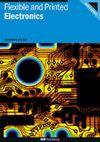Shellac as dielectric materials in organic field-effect transistors: from silicon to paper substrates
IF 3.2
4区 工程技术
Q3 MATERIALS SCIENCE, MULTIDISCIPLINARY
引用次数: 0
Abstract
Recent advances in the design and preparation of electroactive materials, particularly semiconducting and conductive polymers, have resulted in the creation of novel organic electronics with advanced functionality and performance competitive with that of devices made of silicon. With an increasing number of organic and printed electronics being engineered and produced at a larger scale, the environmental cost of the final organic electronic devices (life cycle, environmental impact, etc) needs to be considered. While e-waste is already a growing global problem, improving the sustainability of emerging electronics through a careful materials selection is highly desirable. In this work, we explore the use of shellac as a sustainable greener dielectric material in organic field-effect transistors. A careful examination of shellac in combination with diketopyrrolopyrrole-based semiconducting polymers was performed on rigid substrates through atomic force microscopy (AFM) and the fabrication of thin film transistors. All devices made from this green dielectric showed good performance and device characteristics. Building from this investigation, shellac was further integrated with paper substrates to fabricate paper-based thin film transistors. Thin film samples based on shellac on both silicon wafer and paper substrates were characterized by AFM to investigate solid-state morphology of shellac and selected semiconducting materials. Through careful optimization of the device architecture and processing time, device characteristics and performances on paper substrates (average charge mobilities and on/off current ratios) were comparable to those of devices prepared on silicon wafers, confirming that shellac, in combination with organic semiconducting polymers, can be an advantageous dielectric material to be used for the fabrication of greener and sustainable thin film electronics from renewable feedstocks and components.有机场效应晶体管中的虫胶介电材料:从硅到纸基板
电活性材料,特别是半导体和导电聚合物的设计和制备方面的最新进展,导致了新型有机电子器件的产生,其具有与硅器件竞争的先进功能和性能。随着越来越多的有机和印刷电子产品被大规模设计和生产,需要考虑最终有机电子设备的环境成本(生命周期、环境影响等)。虽然电子垃圾已经是一个日益严重的全球问题,但通过仔细选择材料来提高新兴电子产品的可持续性是非常可取的。在这项工作中,我们探索了虫胶作为一种可持续的绿色电介质材料在有机场效应晶体管中的应用。通过原子力显微镜(AFM)和薄膜晶体管的制造,在刚性基底上仔细检查了虫胶与二酮吡咯并吡咯基半导体聚合物的组合。所有由这种绿色电介质制成的器件都显示出良好的性能和器件特性。在这项研究的基础上,虫胶与纸基板进一步集成,以制造纸基薄膜晶体管。利用原子力显微镜对硅片和纸基紫胶薄膜样品进行了表征,以研究紫胶和所选半导体材料的固态形貌。通过仔细优化器件结构和处理时间,纸衬底上的器件特性和性能(平均电荷迁移率和开/关电流比)与在硅片上制备的器件相当,证实虫胶与有机半导体聚合物结合,可以是一种有利的介电材料,用于由可再生原料和部件制造更环保和可持续的薄膜电子产品。
本文章由计算机程序翻译,如有差异,请以英文原文为准。
求助全文
约1分钟内获得全文
求助全文
来源期刊

Flexible and Printed Electronics
MATERIALS SCIENCE, MULTIDISCIPLINARY-
CiteScore
4.80
自引率
9.70%
发文量
101
期刊介绍:
Flexible and Printed Electronics is a multidisciplinary journal publishing cutting edge research articles on electronics that can be either flexible, plastic, stretchable, conformable or printed. Research related to electronic materials, manufacturing techniques, components or systems which meets any one (or more) of the above criteria is suitable for publication in the journal. Subjects included in the journal range from flexible materials and printing techniques, design or modelling of electrical systems and components, advanced fabrication methods and bioelectronics, to the properties of devices and end user applications.
 求助内容:
求助内容: 应助结果提醒方式:
应助结果提醒方式:


